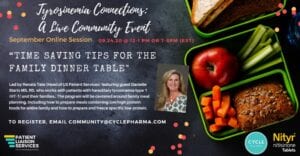Tyrosinemia is a metabolic disorder which prevents the body from processing the amino acid tyrosine. Without treatment, the disorder can be lethal. There are three different types of tyrosinemia with each being distinguished by which mutation causes it. Type 1 is caused by mutations of the FAH gene, type 2 is caused by mutations of the TAT gene, and type 3 is caused by mutations of the HPD gene. Type 1 is the most severe form of the disease; symptoms include jaundice, failure to thrive, bleeding, a cabbage-like odor, intellectual disability, vomiting, diarrhea, respiratory, liver, and kidney failure, abdominal pain, and softening and weakening of the bones. The best treatment for type 1 is a diet low in phenylalanine and tyrosine combined with nitisinone. A liver transplant is an option for patients that fail to respond to this treatment. To learn more about tyrosinemia, click here.
Most patients that are born with tyrosinemia are able to live relatively normal lives with proper diet and medication. While diet can be the key, meeting dietary needs for tyrosinemia isn’t always so simple. Sometimes special protein formulas are necessary, and the specific needs of patients with this condition can make meal planning for your family even more complicated than usual.
Nitisinone treatments come in two forms: Orfadin and Nityr. Nityr is the most recent formulation, which comes in a smaller size (making it easier for children to take) and does not require refrigeration.
If you or someone in your family is living with tyrosinemia then attending the event below can help you plan for the dietary needs of these patients:







